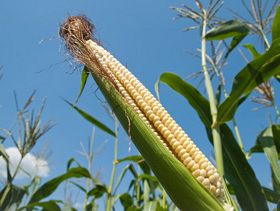 harvest is concluded. Being largely rainfed, cereal production in Morocco is highly variable. Dry conditions in autumn 2013 slowed down wheat planting. Compared to previous year, about 15 per cent less land was planted to cereals. Despite generally favourable weather conditions later in the season, yields were not sufficient to offset the area reduction.
harvest is concluded. Being largely rainfed, cereal production in Morocco is highly variable. Dry conditions in autumn 2013 slowed down wheat planting. Compared to previous year, about 15 per cent less land was planted to cereals. Despite generally favourable weather conditions later in the season, yields were not sufficient to offset the area reduction.The Ministry of Agriculture puts a preliminary cereal production forecast in 2014 at about 7 million tonnes, some 29 per cent below the last year’s exceptionally high harvest, and 16 per cent below the five-year average.
Total wheat harvest is put at 5.1 million tonnes, some 10 percent below the five-year average and 27 per cent below last year. Total barley harvest, used mostly as feed, is forecast at 1.7 million tonnes, about 37 per cent lower than last year and some 32 per cent below the five?year average.
Wheat imports expected to decrease in 2014/15 due to high carry?over stocks
Morocco relies heavily on wheat imports from the international market to cover its consumption needs. Morocco’s cereal imports in 2014/15 (July/June) are forecast at 6.275 million tonnes, seven per cent down on 2013/14, of which wheat imports account for 3.5 million tonnes. EU and Black Sea countries supply most of the common (soft) wheat while Canada is the traditional supplier of durum wheat. Lower import forecast is supported by higher carry?over stocks, despite the below?average 2014 harvest.
The Attijariwafa Bank, one of Morocco’s three major banks, signed a deal with Moroccan wheat trade federation to finance $300 million of Russian wheat imports in the 2014/15 season. Morocco typically imports from October to May (the start of the local harvest). However, wheat importers are seeking to establish a longer window for imports to take advantage of Black Sea exporters offloading large volumes at attractive prices at the start of the international marketing year in July.
In July 2014, the government announced that the common wheat import tariff would be lowered to 17.5 per cent (from the current level of 45 per cent) beginning from 1 September 2014.
Due to excess milling capacity in Morocco, limited quantities of wheat flour are exported to neighbouring countries.
Food inflation remains moderate
The food inflation stood at 0.2 per cent in the 12 months to the end of December 2013. In April 2014 (the last data available), there was no change reported in food indices compared to a year ago. In spite of the country’s high import dependency rate, the impact of the changes in international prices on domestic prices is mitigated by government subsidies of more than one million tonnes of “national flour”, a common wheat of standard quality used to make flour for the low?income consumers. The Government covers the difference between the actual price and guaranteed mill price. Durum wheat is not regulated.
The Government removed fuel subsidies in February 2014, narrowing the fiscal deficit from MAD 36.9bn ($4.4bn) in June 2013 to MAD 23.6bn in June 2014. A reform of food subsidies remains unlikely.





